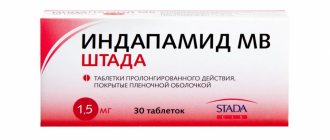Britomar
The drug should be used strictly as prescribed by a doctor.
Patients with hypersensitivity to sulfonamides and sulfonylureas may have cross-sensitivity to the drug. In patients, especially at the beginning of treatment and in the elderly, it is recommended to monitor the electrolyte balance, volume and concentration of circulating blood.
During long-term treatment, it is recommended to regularly monitor electrolyte balance (especially potassium levels), glucose, uric acid, creatinine, lipids and cellular blood components.
For patients receiving the drug in high doses, in order to avoid the development of hyponatremia and metabolic alkalosis, it is not advisable to limit the consumption of table salt.
The risk of hypokalemia is greatest in patients with liver cirrhosis, severe diuresis, insufficient dietary electrolytes, and concomitant treatment with corticosteroids or ACTH.
An increased risk of developing fluid and electrolyte imbalances is observed in patients with renal failure. During the course of treatment, it is necessary to periodically monitor the concentration of blood plasma electrolytes (including sodium, calcium, potassium, magnesium), acid-base status, residual nitrogen, creatinine, uric acid and, if necessary, carry out appropriate corrective therapy (with a higher frequency in patients with frequent vomiting and against the background of parenterally administered fluids).
In patients who have developed fluid and electrolyte disturbances, hypovolemia, or prerenal azotemia, laboratory findings may include: hyper- or hyponatremia, hyper- or hypochloremia, hyper- or hypokalemia, acid-base imbalance, and increased blood urea levels. If these disorders occur, it is necessary to stop taking the drug until normal values are restored, and then resume treatment with the drug at a lower dose. If azotemia and oliguria appear or worsen in patients with severe progressive kidney disease, it is recommended to suspend treatment.
The selection of a dosage regimen for patients with ascites against the background of liver cirrhosis should be carried out in hospital conditions (violations of water and electrolyte balance can lead to the development of hepatic coma). This category of patients requires regular monitoring of blood plasma electrolytes.
To prevent hypokalemia, it is recommended to use potassium supplements and potassium-sparing diuretics (primarily spironolactone), as well as follow a diet rich in potassium.
Taking the drug may cause an exacerbation of gout.
In patients with diabetes mellitus or with reduced glucose tolerance, periodic monitoring of glucose concentrations in the blood and urine is required.
In patients with prostatic hyperplasia and narrowing of the ureters, diuresis control is necessary due to the possibility of acute urinary retention.
In patients with diseases of the cardiovascular system, especially those taking cardiac glycosides, diuretic-induced hypokalemia can cause the development of arrhythmias.
During the treatment period, patients should avoid engaging in potentially hazardous activities that require increased attention and speed of psychomotor reactions.
Features of good stagnation
Closed.
Disease of the liver with cirrhosis and ascites.
The drug Britomar should be administered with special care to patients with liver diseases accompanied by liver cirrhosis and ascites, as a result of rapid changes in the water-electrolyte balance can lead to hepatic coma and. Therapy with the prescribed drug Britomar (as well as other sechoginous diseases) for patients in this group must be carried out in the hospital. To prevent hypokalemia and metabolic alkalosis, the drug should be prescribed with aldosterone antagonist drugs or potassium-sparing drugs.
Ototoxicity.
After taking torasemide, episodes of ototoxicity (noise in the ears and hearing loss) were avoided, which were of a small nature, but a direct connection with the drug was not established. Ototoxicity has also been observed in studies on animals with high levels of torasemide in plasma.
Hypovolemia and disruption of electrolyte balance.
If septic conditions are recognized, it is necessary to carefully monitor the clinical symptoms of electrolyte imbalance, hypovolemia, extrarenal azotemia and other disorders that may manifest themselves in the appearance of dry mouth, with weakness, lethargy, drowsiness, restlessness, muscle pain or swelling, myasthenia , arterial hypotension, oliguria, tachycardia, boredom, vomiting. Superior diuresis can cause the body to become dizzy, lead to a decrease in the volume of circulating blood, thrombus formation and embolism of blood vessels, especially in patients of the summer age.
In patients with impaired water-electrolyte balance, hypovolemia, extrarenal azotemia, changes in laboratory values are possible: hypernatremia, hyponatremia, hyperchloremia, hypochloremia I, hyperkalemia, hypokalemia, disruption of the acid-water balance, increased level of nitrogen in the blood. Such patients should begin to stop taking the drug and, after the undesirable effects have subsided, resume therapy with Britomar, starting with lower doses.
Apparently, in controlled studies conducted in the USA and European countries, torasemide was prescribed to patients with arterial hypertension at doses of 5 or 10 mg per dose. For a long time, there was no precaution to change the average level of potassium in the blood serum. Dose-related hypokalemia was more often observed in patients with congestive heart failure, liver cirrosis, or illnesses such as those treated with torasemide at doses higher than those with antihypertensive conditions. jennyah.
In patients with heart disease, treatment with diuretics and hypokalemia may be a risk factor for the development of arrhythmias, especially in patients who are recovering from digitalis.
The greatest risk for the development of hypokalemia is in patients with liver cirrhosis, increased diuresis, with a salt-free diet and with one-hour treatment with corticosteroids or adrenocorticotropin.
In case of treatment with torasemide, regular laboratory monitoring of electrolyte balance is required, checking the level of potassium in the blood.
Come in safely.
Before starting to administer the drug, it is necessary to treat any existing hypokalemia, hyponatremia or hypovolemia.
In case of treatment with torasemide, regular monitoring of electrolyte balance, glucose levels, sechoic acid, creatinine and blood lipids is required.
Particular attention is required in patients with a tendency to develop hyperuricemia and gout.
Patients suffering from overt or latent diabetes need to control carbohydrate metabolism.
In patients with cardiovascular diseases, especially those taking digitalis preparations, hypokalemia, which can occur when taking sedatives, can precipitate the development of arrhythmia. The risk of hypokalemia is greater in patients with liver cirrosis, in patients with intense diuresis, in patients who suffer from a lack of electrolytes and other medications. corticosteroids and adrenocorticotropic hormone are present.
Data from laboratory tests.
Potassium
. In a follow-up study of patients with arterial hypertension, after 12 years of treatment with torasemide, potassium level decreased significantly. In similar studies with other diuretics, torasemide does not increase the level of potassium in the blood serum.
During long-term studies, torasemide did not increase potassium levels in the blood.
Calcium.
In healthy volunteers, single doses of torasemide increased cross-sectional calcium excretion and decreased calcium levels during four six-year studies of hypertension. In a recent study in patients with congestive heart failure, the mean serum calcium level was reduced by 0.10 mg/dL (0.02 mmol/L). The development of hypocalcemia was not reported as an adverse reaction in 426 patients who were treated with torasemide for 11 months.
Magnesium.
In healthy volunteers, single doses of torasemide increased the excretion of magnesium in the bloodstream, and the level of magnesium in blood serum was found to be significantly elevated in four six-year studies of hypertension. In additional patients with hypertension, the mean change in blood serum magnesium magnesium was increased by 0.03 mg/dL (0.01 mmol/L). One episode of hypomagnesemia (1.3 mg/dL [0.53 mmol/L]) was recorded as an adverse reaction in 426 patients who were treated with torasemide for a median of 11 months.
In a long-term clinical follow-up of torasemide-treated patients with congestive heart failure, the change in blood syringa instead of magnesium in blood serum increased by 0. 2 mg/dL (0.08 mmol/L) (indicator assigned to patients receiving a lot of supplements to contain magnesium) . In a recent study without constant supplementation of magnesium, serum magnesium levels were lower than 1.7 mg/dL (0.70 mmol/L) in 6% and 9% of patients who took 5 mg and 10 mg. torasemide is consistent .
Blood sechoic acid, creatinine and sechoic acid.
Torasemid produces small dose-dependent increases in these parameters. In patients with arterial hypertension who were treated with 10 mg of torasemide over a period of six days, the average increase in the values became: blood serum level – 1.8 mg/dl (0.6 mmol/l), cre tinin – 0.05 mg/dl ( 4 µmol/l) and sechoic acid – 1.2 mg/dl (70 µmol/l). These parameters changed little during the initial bath, and the changes were reversed after the final bath.
About symptomatic gout
was observed in patients who took torasemide, but the frequency was similar to that observed in patients who took placebo.
Glucose.
In patients with arterial hypertension who took 10 mg of torasemide per dose, there was a mean increase in serum glucose concentration of 5.5 mg/dL (0.3 mmol/L) after six days. iv treatment, with further increases of 1.8 mg /dl (0.1 mmol/l) attack. Trival research showed that in patients with diabetes, the average glycemic values did not change during the weekend. Rare episodes of hyperglycemia have been reported.
Blood serum lipids.
During short-term control studies of arterial hypertension, doses of 5, 10, and 20 mg torasemide were associated with increases in plasma cholesterol levels of 4, 4, and 8 mg/dL (0.10–0.20 nmol/L ) obviously. These changes regressed under the hour of intense rejoicing.
In these short-term studies of hypertension, doses of 5, 10, and 20 mg torasemide were associated with mean increases in plasma triglycerides of 16, 13, and 71 mg/dL (0.15 –0.80 nmol/l) consistent.
Trials with stable doses of 5 to 20 mg of torasemide did not show a significant difference compared with the observed values of lipid levels after one treatment period.
Others
. During the course of research in patients with arterial hypertension, torasemide was associated with insignificant increases in the average level of hemoglobin and hematocrit, as well as in the number of erythrocytes, platelets , leukocytes and indicators of urinary phosphatase in serum.
Although these changes were statistically significant, the stench was not without medical implications. When the level of liver enzymes in the blood was studied, no significant changes were observed, except for an increase in the level of hydroxyphosphatase.
Suspension during pregnancy or breastfeeding.
Vaginism.
I will definitely infuse torasemide into the embryo and human pregnancy every day. Experiments on bull animals have shown the reproductive toxicity of torasemide. Torasemid penetrates the placental barrier. In connection with hyperthyroidism, torasemide is used during pregnancy only for vital indications and at the minimum effective dose. Diuretics are not suitable for standard treatment regimens for arterial hypertension or vaginitis, and they can reduce the perfusion of the placental barrier and cause toxic influx on the intrauterine development of the fetus . If torasemide is prescribed for the treatment of vaginitis due to heart failure or nutrient deficiency, it is necessary to closely monitor the level of electrolytes and hematocrit, as well as fetal development.
Lactation period.
It has not yet been determined whether torasemide penetrates into breast milk in animals or humans. It is not possible to turn off the rizik for newlyweds/unborns. Therefore, administration of torasemide during lactation is contraindicated. If it is necessary to stop torsemide during this period, then breastfeeding should be discontinued.
Fertility.
The effects of torasemide on fertility have not been studied in humans. Experiments on animals did not reveal anything like this.
This is due to the fluidity of the reaction during treatment with vehicles or other mechanisms.
When torsemide is kept at recommended doses, it may affect the patient’s reaction and cause a significant negative impact on the delivery of care by motor transport or interfere with the work with other mechanisms. It is important to take medicine, increase the dosage of the drug, replace the medication, or use concomitant therapy. Therefore, before the time of drying out of torasemide, it is necessary to be especially careful when handling it with vehicles or other mechanisms.
Directions for use and doses
Taken orally. The tablets should be swallowed whole, without chewing, with liquid. The tablets can be taken at any convenient time, regardless of meals.
- Edema syndrome in chronic heart failure: the initial dose is usually 10-20 mg 1 time / day. If necessary, the dose can be increased by 2 times until the desired effect is obtained.
- Edema syndrome in kidney disease: the initial dose is usually 20 mg 1 time / day. If necessary, the dose can be increased by 2 times until the desired effect is obtained.
- Edema syndrome in liver disease: the initial dose is usually 5-10 mg 1 time / day together with aldosterone antagonists or potassium-sparing diuretics. If necessary, the dose of Britomar can be increased by 2 times until the desired effect is obtained. A single dose of more than 40 mg is not recommended, because its effect has not been studied. The drug is prescribed for a long period or until the swelling disappears.
- Arterial hypertension: the initial dose is usually 5 mg 1 time / day. If there is no adequate reduction in blood pressure within 4-6 weeks, the dose is increased to 10 mg 1 time / day. If this dose does not give the required effect, an antihypertensive drug from another group must be added to the treatment regimen.
If you miss a regular dose, you should not take a double dose of the drug. The forgotten dose should be taken immediately. The next dose is taken at the usual time the next day.







